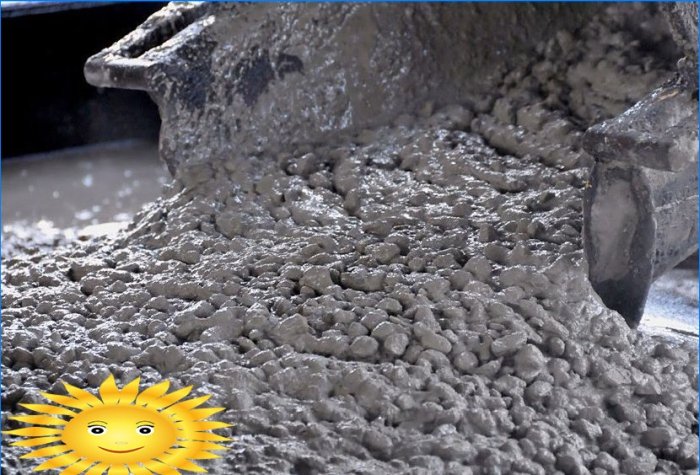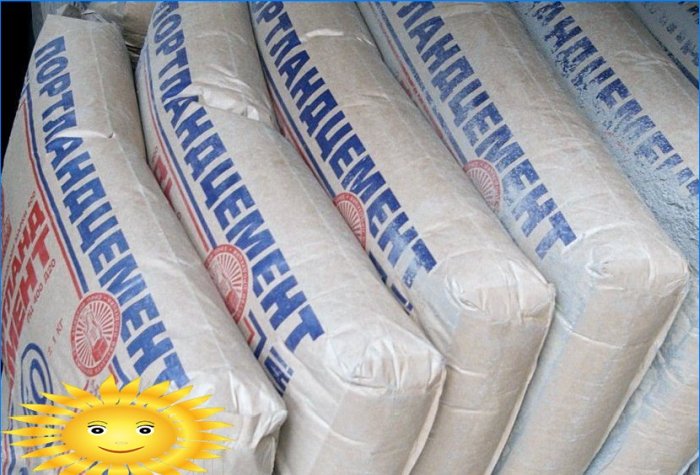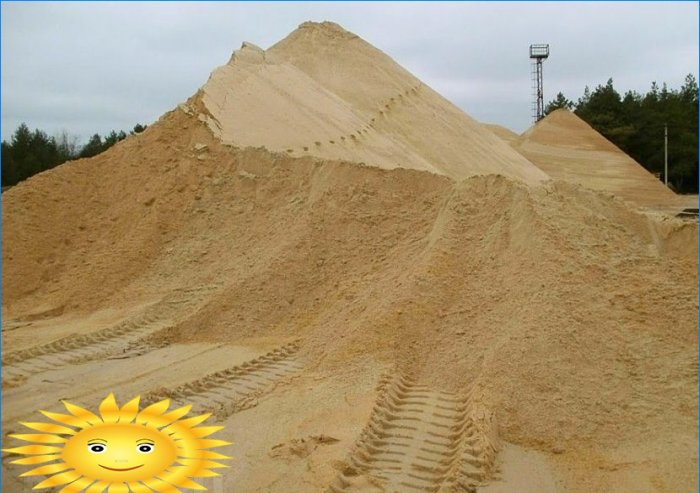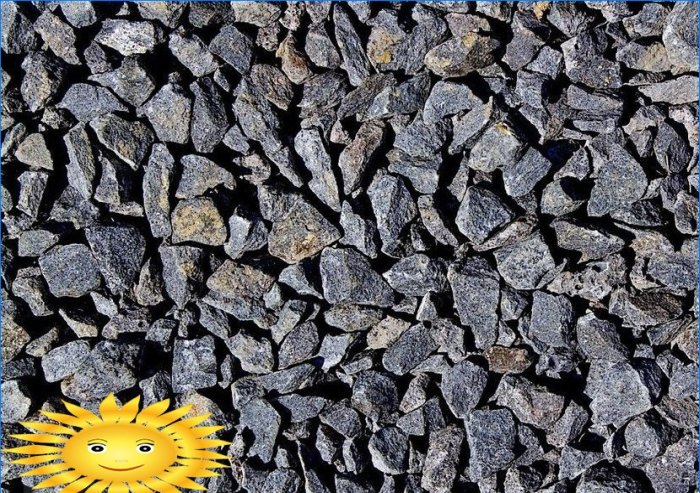Recommendation points
- The main indicators of concrete for the foundation
- Required materials for heavy concrete
- Portland cement
- Sand
- Gravel or crushed stone
- Water
- Calculation of the composition of the concrete mix
The concrete for the foundation is prepared with the exact proportion of the ingredients. All components are selected in accordance with the standards and GOST to ensure the required grade of concrete. Calculation of the composition determines the economical consumption of materials to obtain the required strength, mobility and other indicators of concrete.
The main indicators of concrete for the foundation
Concrete is a material obtained as a result of the setting and further hardening of a mixture: binder, aggregates, water. For foundations, heavy concrete is used, in which Portland cement is the binder. Aggregates are sand, gravel (crushed stone).
The structure of the foundation perceives mainly compressive loads, therefore the main indicator of concrete is its class (B) – compressive strength. For foundations, it is B12.5 (M150) and B15 (M200).
An important indicator under various climatic conditions is the concrete grade (F) for frost resistance. It reflects the minimum number of freezing and then thawing that a standard sample withstands and is assigned from F 15 to F 1000.
The foundation can be influenced by water in the ground. In this case, a concrete grade (W) is assigned for water resistance, which is taken in the range of W 2 – W 20. It expresses the maximum water pressure (MPa · 10-1) that the standard sample can withstand.
Another important indicator for concrete is the average density grade D, which is equal to the average volumetric mass of concrete (kg / m3). Its limits are D200 – D5000.
When choosing the composition of the concrete mixture, they focus on the most important indicator for a given structure, taking into account the construction conditions. Other indicators must also be met..
Required materials for heavy concrete
The reliability of the foundation structure directly depends on the quality of its constituent materials.
Portland cement
Portland cement is a hydraulic binder produced by grinding cement clinker. Its main properties include volumetric weight. In a loose state, it is 900-1100 kg / m3 and 1400-1700 kg / m3 – in tight.
An important indicator of cement, which affects the speed of setting and further hardening, is the fineness of grinding. Finer grinding increases concrete strength.
The setting time determines, in addition to the fineness of grinding, the mineralogical composition of the cement and its water demand. The hardening process requires about 15% water by weight of the cement, but much more water is needed to ensure the mobility of the cement paste.
The strength of the cement is characterized by its brand. It is determined by testing a special sample. For the foundation, the grade of which is M150, M200, the grade of Portland cement is taken as M300, M400.
Sand
Sand for concrete mix is used both of natural and artificial origin (crushing of rocks). For heavy concrete, quartz sands are most often used, as more durable.
Foreign impurities in sand reduce the strength of concrete, therefore they are standardized by GOST.
Impurities are limited by weight standards:
- clay and silty – 3%;
- sulfuric and sulfurous – 1%;
- organic – 3%;
- mica – 0.5%.
In the construction of in-situ concrete foundations, sand of medium size (0.25 mm) is used.
Gravel or crushed stone
Gravel or crushed stone is a large aggregate. By origin, gravel is divided into:
- river;
- mountain;
- nautical.
Crushed stone is obtained as a result of crushing, most often, rocks to a particle size of 5 × 70 mm. Crushed artificial stones are sometimes used.
The content of particles of weak rocks in a coarse aggregate is allowed less than 10% of the weight of crushed stone (gravel). The concrete grade must be at least 2 times lower than the gravel (crushed stone) grade.
Impurities (clay, dust particles, mica, organic, sulfurous and sulfuric acid inclusions) impair the properties of concrete. Their number is limited to three percent.
Water
Drinking water must be used. Substances that negatively affect the strength of concrete should be absent in its composition. These include sulfates, acids, fats, oils, sugars, etc. The pH is allowed less than 4.
Sea water can only be used if it contains less than 5000 mg / l of mineral salts, while sulfates must be less than 2700 mg / l.
Calculation of the composition of the concrete mix
Concrete for foundations is used in class B12.5 (M150) and B15 (M200), depending on the perceived load. In order to obtain the required concrete strength and economically use materials, a calculation is made for the amount of all components. In this case, the small number of air pores is neglected..
The calculation is made for a compacted mixture per 1 m3 concrete according to the formula:
- Ц, В, П, Щ – cement, water, sand, crushed stone (gravel) in kg / m3;
- ??c, ?? v, ?? n, ?? u – specific gravity of materials.
It is very important to know the water-cement ratio, which affects both the strength and the mobility of the concrete mixture. Mobility (workability) is the ability of the mixture to spread, determined by the “cone draft”. A standard metal mold without a bottom is filled with a concrete mixture. After removing the mold, it spreads. The slump height of the concrete mix is an indicator of the mobility.
Mobility (workability) divides mixtures into:
- hard;
- movable;
- cast.
For the construction of foundations, rigid mixtures are used, the draft of the cone for them is allowed 0–2 cm. To determine the water-cement ratio on the basis of special calculation formulas, tables and graphs have been developed. According to their data for the foundation (concrete B12.5, B15), the water-cement ratio is:
- B12.5 (brand of cement 300) B / C = 0.68;
- B15 (brand of cement 300) B / C = 0.56;
- B15 (cement grade 400) B / C = 0.68.
According to tables and formulas, it can be determined that for a rigid mixture (workability 30-50 sec) with a gravel size of 20-40 mm, the water consumption per 1 m3 of concrete will be 135 × 155 l / m3. When using crushed stone or fine sand, the water consumption increases by 10%. Cement consumption is determined from the formula:
- C = V / (V / C),
- Where IN – water consumption in kg.
Next is the quantitative composition of sand and gravel (crushed stone). This calculation requires specific indicators of the used aggregates and is carried out under laboratory conditions. The laboratory consumption is subsequently recalculated taking into account the natural moisture content of the aggregates.
For the convenience of calculating the amount of concrete mix components for the entire structure, the ratio of the amount of sand, crushed stone (gravel) to the amount of cement per unit volume of concrete is determined:
- 1: P / C: U / C – by weight;
- 1: VP / Vc : Vu / Vc – by volume.
Concrete consumption for small volumes of construction and relatively low loads on the foundation can be selected according to table 1.
Table 1. Approximate consumption of concrete constituents M150 and M200
Portland cement brands 300 400 Concrete grade 150 150 200 by weight; by volume at a flow rate of 1 m3 concrete by weight; by volume at a flow rate of 1 m3 concrete by weight; by volume at a flow rate of 1 m3 concrete cement, kg water, l cement, kg water, l cement, kg water, l 1: 2.85: 4.75 1: 2.15: 4.1 255 155 1: 3.5: 5.7 1: 2.6: 4.9 215 155 1: 3: 4.75 1: 2.25: 4.1 250 155
Our home is our fortress. This is guaranteed by a solid foundation made of quality concrete..











What are the recommended brands of concrete for foundation construction? How do I determine the appropriate proportions of cement, aggregates, and water to use? Can you guide me on the calculation process to ensure a strong and durable foundation?